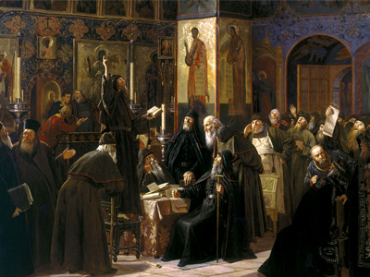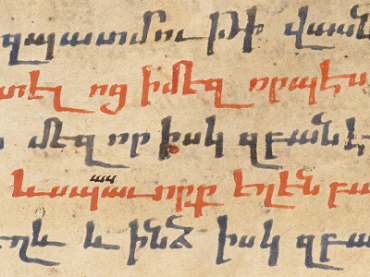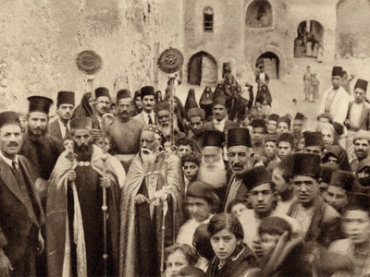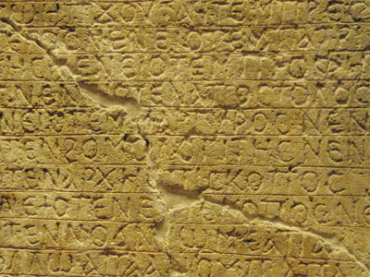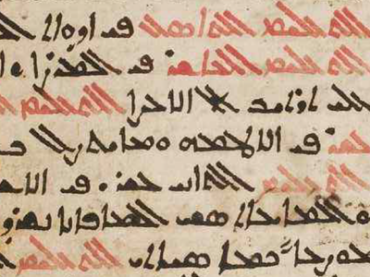Syriac and Eastern Christianity
The Other Mathematics
Language and Logic in Egyptian and in General
By Leo Depuydt
Series: Gorgias Studies in the Ancient Near East 5
ISBN: 978-1-59333-369-0
This book is about attribute mathematics, in which nothing ever gets bigger or smaller. More specifically, it is about some of what attribute mathematics can do toward the full digitalization of thought and language. The matter is relevant not only directly to linguistics and philosophy but also indirectly to electrical engineering and neuroscience. The twenty-first century will be that of the brain. Human existence will gradually be turned inside out as tools such as genetics and Boolean algebra allow us to see ourselves function on the smallest scale while it is happening.
$181.00
The Book of the Laws of Countries
Dialogue on Fate of Bardaisan of Edessa
ISBN: 978-1-59333-371-3
The Book of the Laws of Countries (BLC) by Bardaisan of Edessa belongs to the most important writings of early Syriac literature. The text reflects the intellectual climate of northern Mesopotamia and in particular that of the city of Edessa, at the end of the second century and the first decades of the third century CE.
$105.00
The Theological Apologia of Mar Nestorius
Nestorius Le Livre D'Heraclide
By Paul Bedjan
ISBN: 978-1-59333-400-0
Nestorius, deposed by the Council of Ephesus, spent his final years composing an apologia defending his theological beliefs, which became known as the ‘Book (or ‘Bazaar’) of Heraclides’. The Greek original is lost, but this Syriac translation survived in a single manuscript in the library of the Catholicos of the East, in his mountain retreat of Qodshanes. Bedjan gives an edition of this vital Syriac text.
$293.00
The Baqubah Refugee Camp
An Account of Work on Behalf of the Persecuted Assyrian Christians
By H. H. Austin
ISBN: 1-59333-401-X
This book gives a detailed picture of the Baqubah refugee camp by the commandant of the camp. Austin discusses the camp’s organization and daily life. The book also discusses the work of the “Assyrian Contingent” that was formed in the camp.
$105.00
The Book of the Bee
Edited by E. A. W. Budge
ISBN: 1-59333-402-8
The Book of the Bee is a collection of theological and historical texts compiled by Solomon of Akhlat in the thirteenth century. The book consists of 55 chapters discussing various topics including the creation, heaven and earth, the angels, darkness, paradise, Old Testament patriarchs, New Testament events, lists of kings and patriarchs, and the final day of resurrection. This edition by E. A. W. Budge gives the original Syriac text with an English translation. The edition also includes an extract from the Arabic version of the same text.
$173.00
The Catholicos of the East and His People
The Impression of Five Years' Work in the "Archbishop of Canterbury's Assyrian Mission"
ISBN: 1-59333-403-6
Describes the life and customs, both ancient and modern, of the modern Assyrians (“Nestorians”) who formed in the nineteenth century a remarkable outpost of Christianity in the Middle East. The authors rely in their descriptions on the Sunhadus, or Book of Canon Law, which governs that Church even today.
$178.00
Missionary Life in the Middle East
Or Yesterday in Persia and Kurdistan
ISBN: 1-59333-404-4
This work depicts the life of the missionary in the Middle East during the nineteenth century. The book begins with a history of Persia and its topography and character. Then the author gives a travelogue of his journeys in the Middle East, describing aspects of daily life. The modern Assyrians and Kurds get a prominent place in the book. The author describes places in modern Iran, Iraq and Turkey.
$165.00
Christians Under the Crescent in Asia
New Introduction by David Malick
By E. L. Cutts
ISBN: 1-59333-405-2
An account of a journey among the Assyrians in Turkey and Persia in 1876. The author, Edward L. Cutts, was sent on a mission of inquiry by the Archbishop of Canterbury in response to petitions from Assyrians to the Church of England requesting the establishment of a mission to open schools among them in order to bring about their educational and spiritual renewal.
$176.00
The Condition of Assyrianism in the Era of the Incarnation of Our Lord
New Introduction by David Malick
ISBN: 1-59333-406-0
Mirza Dawid Gewargis Malik (1876-1931) was a prolific writer in Neo-Aramaic (modern Assyrian). This volume contains the texts of two of his books, a collection of poems, one of which is dedicated to Nicolas II, Emperor of Russia, and Notes on the History of Assyria.
$129.00
History of the Syrian Nation and the Old Evangelical-Apostolic Church of the East
New Introduction by David Malick
ISBN: 1-59333-408-7
This book is the first account written in English on the history of the Church of the East by one of its own adherents. The basis of the book is a history that was written in Assyrian (Neo-Aramaic) by Shamasha George David Malech (1837-1909).
$202.00
A Residence of Eight Years in Persia among the Nestorian Christians with Notices of the Muhammedans
Series: Kiraz Historic Travels Archive 30
ISBN: 1-59333-410-9
Gives a travelogue and a journal of his missionary activities in the Middle East between 1834 and 1841, primarily with the Church of the East.
$228.00
An Account of the Massacres of Christians by the Turks in Persia
ISBN: 1-59333-411-7
The Rage of Islam is a chilling account of the massacres that befell the Christians of Persia in 1915. The book provides a good description of the massacres of 1915 from the point of view of a native Assyrian.
$146.00
The Life of William Ambrose Shedd, Missionary to Persia
With a Biography of W. A. Shedd by Heleen (H.L.) Murre-van den Berg
ISBN: 1-59333-412-5
This book gives the biography of William Ambrose Shedd (1876-1918), written by Mary Lewis Shedd, the wife of his last years. W. A. Shedd was an American Protestant missionary who was born in Urmia, Iran, and spent most of his life there among the Assyrian Christians of northwestern Iran. He received his education in Princeton.
$157.00
The Tragedy of the Assyrians
ISBN: 1-59333-413-3
The Tragedy of the Assyrians depicts the massacres that befell the Assyrians in Iraq in 1933, following their uprooting from their homelands during World War I.
$139.00
The History of Yaballaha III and of His Vicar Bar Sauma
Series: Kiraz Chronicles Archive 13
ISBN: 1-59333-414-1
This book gives an introduction and an annotated English translation of the Syriac account of Yaballaha III, Church of the East Patriarch, and his vicar Bar Sauma, the Mongol Ambassador to the Frankish courts at the end of the thirteenth century. The translation is based on Bedjan’s 1895 edition of the Syriac text (also available from Gorgias Press). In addition to the translation, a survey of the Mongols and their relation to the West is given, as well as a brief history of the "Nestorian" Church.
$107.00
An Anthology of Syriac Texts
By Anonymous
ISBN: 1-59333-415-X
An anthology of Syriac texts from the Syriac fathers. Each author is first introduced in Syriac, and then excerpts from his writings are given. The texts begin with the Abgar Legend (the Acts of Addai) and end with the writings of the sixteenth century author Abdisho of Jazirah.
$183.00
The Platonic Theology of Ioane Petritsi
Series: Gorgias Eastern Christian Studies 4
ISBN: 978-1-59333-395-9
Gigineishvili’s study is a comprehensive exposition of the philosophical system of twelfth-century Georgian Christian Neoplatonist philosopher Ioane Petritsi. Petritsi translated and commented on Proclus’ "Elements of Theology." The translation needed the creation of a philosophic language—a medium for transmitting the extravagant philosophic ideas into Georgian—which Petritsi effectively achieved. Petritsi both explains intricacies of Proclus’ thought and tries to prove the basic affinity between the Platonic and the biblical traditions. Gigineishvili exposes the entire system of Petritsi’s thought on a background of ideas of Proclus, other Neoplatonists, and of the Church Fathers.
$193.00
Nestorian Questions on the Administration of the Eucharist by Isho'yabh IV
A Contribution to the History of the Eucharist in the Eastern Church
ISBN: 1-59333-409-5
Willem Cornelis van Unnik gives a comprehensive research of the liturgical writings of Isho’yabh IV in the context of the "Nestorian" liturgical tradition based on the manuscript tradition. After an analysis of the text, the author gives an annotated English translation of the text and a reproduction of the original Syriac text with a critical apparatus.
$181.00
Ephrem’s Art of Symbolic Thought
ISBN: 1-59333-397-8
Ephrem the Syrian is known as one of the greatest Christian poets and as a unique author whose mode of thought is usually described as “symbolic.” In this work, Kees den Biesen explores the literary, intellectual, and theological mechanisms at work in Ephrem’s writings with the specific aim of identifying the exact nature of his “symbolic thought” and evaluating its contemporary relevance. Den Biesen elaborates a comprehensive approach that integrates a variety of methods into a genuinely theological methodology. He then proposes his own comprehensive understanding of the nature and merits of Ephrem’s symbolic thought.
$197.00
A Critical Examination of the Peshitta Version of the Book of Ezra
ISBN: 1-59333-399-4
This work fills a lacuna in the literature devoted to Peshitta studies and Old Testament textual criticism. The author examines the works of nineteenth- and early twentieth-century scholarship in the field, including the works of Nöldeke, Duval, Wright and others, and proposes corrections to the Syriac text of the Book of Ezra available then. The author then proceeds systematically through the Book of Ezra, giving the critical analysis of the text verse by verse.
$103.00
A Dialogue on Free Will versus Fate, A Key-Word-in-Context Concordance
ISBN: 978-1-59333-374-4
This key-word-in-context concordance will facilitate the study of the very early Syriac text called The Book of the Laws of the Countries, a dialogue on free will versus fate between the Edessean philosopher Bardaisan and his interlocutor Awida.
$146.00
Neo-Aramaic Dialect Studies
Proceedings of a Workshop on Neo-Aramaic held in Cambridge 2005
Series: Gorgias Neo-Aramaic Studies 1
ISBN: 978-1-59333-423-9
This volume contains a collection of papers presented at the workshop on various aspects of the grammar of Neo-Aramaic, with special attention to the North Eastern Neo-Aramaic dialect group. The papers include descriptions of several hitherto undescribed dialects together with sample texts and also studies of various aspects of phonology, morphology and syntax of the dialects.
$136.00
Lishan Didan, Targum Didan
Translation Language in a Neo-Aramaic Targum Tradition
By Margo Rees
Series: Gorgias Neo-Aramaic Studies 3
ISBN: 978-1-59333-426-0
This study examines the language and translation technique used in a modern “targum” of the Bible. The targum – referred to as “Manuscript Barzani” – is a written preservation of a tradition of Jewish Neo-Aramaic Bible translation, originally transmitted in oral form among the religious leaders of a community in Iraqi Kurdistan. It represents a literary form of the Neo-Aramaic spoken by the Jews of the Rewanduz/Arbel region. Within their community, the targum was used in the schools to teach the language and text of the Hebrew Bible to the young men.
$164.00
The Jewish Neo-Aramaic Dialect of Urmi
Series: Gorgias Neo-Aramaic Studies 2
ISBN: 978-1-59333-425-3
This volume presents a description of the Neo-Aramaic dialect that was spoken by the Jews of Urmi in north-western Iran but which is now virtually extinct. The material for the volume was gathered firsthand in fieldwork conducted with the last remaining speakers in Israel. The volume consists of a detailed grammatical description, a corpus of transcribed texts, including folktales, historical accounts and portrayals of customs, and an extensive glossary.
$241.00
A Syriac Compendium of Eleven Ecumenical Councils
Compendium Conciliorum Œcumenicorum Undecim, edited by Paul Bedjan
ISBN: 978-1-59333-417-8
Joseph Ma'aruf (1693-1713) produced (via an Arabic translation of the Latin) this Syriac compendium of eleven key ecumenical councils acknowledged by the Catholic Church. It is still read today, by Syriac-speaking Christians who wish to have a concise introduction to the theological decrees and canons of these great church councils which defined Catholic faith.
$155.00
Filter by
Filter by price
Filter by manufacturer


